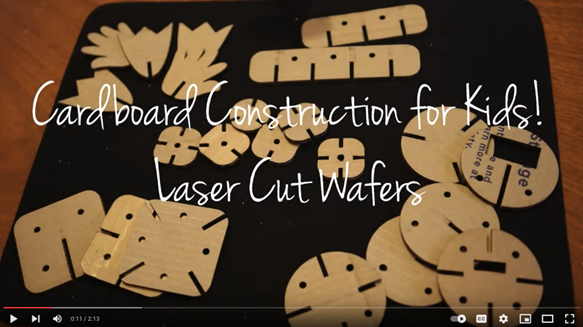# Module 2. Week 1.
# Student-Centered Learning Approaches
# Summary and core material
- Presentation (opens new window)
- Video Recording (opens new window)
- Discord link (opens new window)
- Online platform editor (opens new window)
# Assignment
The main task of this week is to create a 3D object with the laser cutter. As material we strongly recommend using cardboard. Cardboard is a great material for initial prototypes.
You have two options:
- Option 1:
- Create a press-fit build kit using the laser cutter
- Your kit should have at least 10 pieces that can interlock
- Build something with your kit and snap a photo
- You can have only one shape, but if you would like to explore more the options, you can consider having 3 or 4 different shapes in your kit.

- Option 2:
- Use any of the tools presented in the master class, and create a 3D object using any of the joint techniques presented: finger joints, stacking...
- You can use either a CAD tool to build your 3D object, or you can use any of the tools to build objects such as boxes.py.
- Put all the parts together, and snap a photo
- If needed do not be afraid of using e.g glue.
In both options is highly recommended that you use cardboard as material.
In addition you should answer the following reflection questions:
How your press-fit can be utilized in education? How other teachers could use it?
What has been your experience using Project Based Learning / Problem based learning in the past? What were the main challenges? How DF can support Project Based Learning / Problem Based learning?
When organizing DF activities with kids, What are the aspects that you think should be prepared beforehand? What aspects can be improvised?
# Tasks in the Fab Lab
- Introduction to 3D design for laser cutting. Creating simple 3D shapes using a CAD tool.
- Explore different alternatives to create 3D parts with the laser cutter: tabs, layers...
# Asynchronous content
# Intro to Materials. Cardboard
Will be added in the future.
# CAD resources
This section provides a curated set of resources where you can find 2D and 3D cad models that can be used for inspiration or taking some models that can be later modified.
- CAD Library (opens new window). Peer reviewed DF files and learning resources for use in the classroom
- SCOPESdf.org (opens new window) -opensource lesson repository for df in education (mostly df WITH kids)
# 2D Resources
- Vecteezy (opens new window) - Offers free and premium vector art, illustrations, and graphic design elements suitable for creating educational posters, handouts, and visuals.
- SVGRepo (opens new window) - A massive collection of SVG files, many of which are simple shapes and outlines perfect for laser cutting. The educational section includes icons and diagrams that can be used directly.
- Ponoko (opens new window) - Offers a library of free, laser-ready designs in DXF and SVG formats. These include fun projects like puzzles, educational aids, and practical templates ready for cutting.
- Thingiverse (opens new window) - Though primarily a 3D model platform, Thingiverse has a dedicated section for laser-cutting designs, including educational projects and puzzles. Files are usually ready for vector-based editing software.
# 3D Resources
- Thingiverse (opens new window) - A massive repository of free 3D models, great for makers and 3D printing enthusiasts.
- Sketchfab (opens new window) - An online platform for publishing, sharing, and discovering 3D content. It offers both free and paid models, with a focus on community-generated designs.
- Tinkercad (opens new window) - A user-friendly online platform for creating 3D designs. It includes a gallery of user-generated models that can be freely accessed and modified. Ideal for beginners.
- NASA 3D Resources (opens new window) - Offers a collection of 3D models related to space exploration, including spacecraft and planetary bodies, which can be used in science education.
# Technical guides and tutorials
# Tutorials on 3D design
- Use Fusion 360 to design and slice a 3D shape for laser-cutting (opens new window) - Learn Fusion 360: Slicing Organic Forms for Laser Cutting
# Creating 3D objects with laser cutter
- Laser-cut Wafer Construction Kit Overview (opens new window) - Cardboard Construction for Kids - Laser Cut Wafers
- 10 Laser-cut Projects for Fun (opens new window) - 10 projects for the laser cutter
- The Trick to Making Laser-Cut Boxes (opens new window) - The Trick With Laser Cut Box Joints
- Design a lamp to be laser-cut using Tinkercad (opens new window) This tutorial presents how to use Tinkercad to design a floor lamp that can be laser cut and assembly easily. Tutorial made by Iván Sánchez for Fab Lab Oulu.
- Design a small storage cabinet for electronics components to be laser-cut using Tinkercad This tutorial presents how to use Tinkercad to design a storage cabinet with small drawers, that you can use for instance to store electronic components. Tutorial made by Iván Sánchez for Fab Lab Oulu.
# Additional and support content
# Project Based and Problem Based Learning
- Udacity: Problem-Based Learning Video Overview (opens new window) - Problem Based Learning
- Udacity: Project-Based Learning Overview (opens new window) - Project Based Learning
- Buck Institute (opens new window) - What is Project-Based Learning (PBL)
- Project-Based Learning Overview (opens new window) - Overview of Project-Based Learning
- Project-Based Learning Examples (opens new window) - Teacher Guide and Examples for PBL
- Project vs. PBL (opens new window) - Differences Between Projects and Project-Based Learning
- Problem-Based Learning Overview Slideshow (opens new window) - Slideshow on Problem-Based Learning
